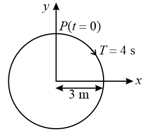EASY
Earn 100
Initial phase of the particle executing SHM with is:
(a)
(b)
(c)
(d)
50% studentsanswered this correctly
Important Questions on Simple Harmonic Motion
HARD
EASY
EASY
MEDIUM
EASY
EASY
EASY
EASY
Which one of the following graph shows correctly the variation with ?
EASY
HARD
MEDIUM
EASY
MEDIUM
HARD
EASY

-projection of the radius vector of rotating particle is
HARD
HARD
MEDIUM
The position co-ordinates of a particle moving in a coordinate system is given by
and
The speed of the particle is:
EASY
EASY

